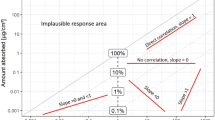Abstract
The acute toxic class (ATC) methods were developed for determining LD50/LC50 estimates of chemical substances with significantly fewer animals than needed when applying conventional LD50/LC50 tests. The ATC methods are sequential stepwise procedures with fixed starting doses/concentrations and a maximum of six animals used per dose/concentration. The numbers of dead/moribund animals determine whether further testing is necessary or whether the test is terminated. In recent years we have developed classification procedures for the oral, dermal and inhalation routes of administration by using biometric methods. The biometric approach assumes a probit model for the mortality probability of a single animal and assigns the chemical to that toxicity class for which the best concordance is achieved between the statistically expected and the observed numbers of dead/moribund animals at the various steps of the test procedure. In previous publications we have demonstrated the validity of the biometric ATC methods on the basis of data obtained for the oral ATC method in two-animal ring studies with 15 participants from six countries. Although the test procedures and biometric evaluations for the dermal and inhalation ATC methods have already been published, there was a need for an adaptation of the classification schemes to the starting doses/concentrations of the Globally Harmonized Classification System (GHS) recently adopted by the Organization for Economic Co-operation and Development (OECD). Here we present the biometric evaluation of the dermal and inhalation ATC methods for the starting doses/concentrations of the GHS and of some other international classification systems still in use. We have developed new test procedures and decision rules for the dermal and inhalation ATC methods, which require significantly fewer animals to provide predictions of toxicity classes, that are equally good or even better than those achieved by using the conventional LD50/LC50 methods. In order to cope with rather narrow dose/concentration classes of the GHS we have, as in our previous publications, combined the outcome of all results that can be obtained during testing for the allocation to one of the defined toxicity classes of the GHS. Our results strongly recommend the deletion of the dermal LD50 and the inhalation LC50 test as regulatory tests and the adoption of the dermal and inhalation ATC methods as internationally accepted alternatives.









Similar content being viewed by others
References
Bliss CI (1934) The methods of probits. Science 79:38–39
Diener W (1998) Biometric evaluation of the ATC method for the determination of the acute dermal toxicity of chemicals. Biometrical J 40:979–991
Diener W, Schlede E (1999) Acute toxic class methods: alternatives to LD/LC50 tests. ALTEX 1:129–134
Diener W, Siccha L, Mischke U, Kayser D, Schlede, E (1994) The biometric evaluation of the acute-toxic-class method (oral). Arch Toxicol 68:599–610
Diener W, Mischke U, Kayser D, Schlede E (1995) The biometric evaluation of the OECD modified version of the acute toxic class method (oral). Arch Toxicol 69:729–734
Diener W, Kayser D, Schlede E (1997) The inhalation acute toxic class method: test procedures and biometric evaluations. Arch Toxicol 71:537–549
Diener W, Kayser D, Schlede E (1998) The dermal acute toxic class method: test procedures and biometric evaluations. Arch Toxicol 72:751–762
Finney DJ (1971) Probit analysis, 3rd en. Cambridge University Press, Cambridge
OECD (1981a) Guideline for the testing of chemicals: acute dermal toxicity (TG 402). Adopted 12 May 1981. Organization for Economic Co-operation and Development, Paris
OECD (1981b) Guideline for the testing of chemicals: acute inhalation toxicity (TG 403). Adopted 12 May 1981. Organization for Economic Co-operation and Development, Paris
OECD (1981c) Guideline for the testing of chemicals: acute oral toxicity (TG 401). Adopted 12 May 1981. Organization for Economic Co-operation and Development, Paris
OECD (2001a) Guideline for the testing of chemicals: acute oral toxicity—acute toxic class method (TG 423). Adopted 22 March 1996; revised method adopted 17 December 2001. Organization for Economic Co-operation and Development, Paris
OECD (2001b) Guideline for the testing of chemicals: acute oral toxicity fixed dose procedure (TG 420). Adopted 17 July 1992; revised method adopted 17 December 2001. Organization for Economic Co-operation and Development, Paris
OECD (2001c) Guideline for the testing of chemicals: acute oral toxicity up-and down procedure (TG 425), Adopted: 21 September 1998; revised method adopted: 17 December 2001. Organization for Economic Co-operation and Development, Paris
OECD (2001d) Harmonized integrated classification system for human health and environmental hazards of chemical substances and mixtures. Organization for Economic Co-operation and Development, Paris. Available online: http://www1.oecd.org/ehs/class/Harmonizedintegrated.pdf (Chapter 2.1)
OECD (2001e) Deletion of TG 401. C/M (2001) 26/PROV of 8 January 2002. Organization for Economic Co-operation and Development, Paris
Pauluhn J, Bury D, Föst U, Gamer A, Hoernicke E, Hofmann T, Kunde M, Neustadt T, Schlede E, Schnierle H, Wettig K, Westphal D (1996) Acute inhalation toxicity testing. considerations on technical and regulatory aspects. Arch Toxicol 71:1–10
Roll R, Höfer-Bosse T, Kayser D (1986) New perspectives in acute toxicity testing of chemicals. Toxicol Lett Suppl 31:86
Roll R, Riebschläger M, Mischke U, Kayser D (1989) Neue Wege zur Bestimmung der akuten Toxizität von Chemikalien. Bundesgesundheitsblatt 32:336–341
Russell WMS, Burch RL (1959) The principles of humane animal techniques. Methuen, London, p 238
Schlede E, Mischke U, Roll R Kayser D (1992) A national validation study of the acute-toxic-class method an alternative to the LD50 test. Arch Toxicol 66:455–470
Schlede E, Mischke U, Diener W, Kayser D (1995) The international validation study of the acute toxic class method (oral). Arch Toxicol 69:659–670
Unkelbach HD, Wolf T (1985) Qualitative Dosis-Wirkungs-Analysen. Gustav Fischer Verlag, Stuttgart,
Acknowledgment
The excellent assistance of Kerstin Schlegel is greatly acknowledged.
Author information
Authors and Affiliations
Corresponding author
Rights and permissions
About this article
Cite this article
Holzhütter, H.G., Genschow, E., Diener ✝, W. et al. Dermal and inhalation acute toxic class methods: test procedures and biometric evaluations for the Globally Harmonized Classification System. Arch Toxicol 77, 243–254 (2003). https://doi.org/10.1007/s00204-002-0424-9
Received:
Accepted:
Published:
Issue Date:
DOI: https://doi.org/10.1007/s00204-002-0424-9




